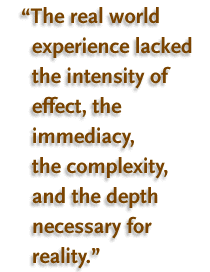 n July 31, 1995, UC- Berkeley economics professor Brad De Long, reeling from virtual shock, posted the following on an Apple users' email list:
n July 31, 1995, UC- Berkeley economics professor Brad De Long, reeling from virtual shock, posted the following on an Apple users' email list:For the past year or so one of my main Internet activities has been to look for pictures of dinosaurs. My five-year-old sits on my right knee and my two-year- old on my left. We stare Triceratops eye-to-eye, and count the teeth of Tyrannosaurus rex.
One of our favorite places is the University of California Museum of Paleontology -- the UCMP. On the Internet, the UCMP is a marvelous virtual, interactive museum. Last June I stopped being a Senior Treasury Department Official, and became a Berkeley economics professor. I asked around, and was told that the UCMP had just moved into the newly renovated Valley Life Sciences Building.
One afternoon my kids and I wandered over to the Valley Life Sciences Building. We walked past a wall of news clippings and pictures of paleontological digs. We soon found ourselves in the central stairwell in front of a banner that said "University of California Museum of Paleontology." There was a very impressive Tyrannosaurus skull behind glass. On the next floor up there was a similarly impressive Triceratops skull. The hip bones of a Tyrannosaurus hung suspended in the stairwell.
The public fossil collection is very small: the UCMP is a research museum; not a display museum: it is for 25-year-old graduate students fascinated by posters with titles like "Acid Rain an Agent of Extinction at the K-T Boundary -- Not!" It's not designed for five-year-olds.
I stood in the stairwell. I thought to myself, "Let's get back to my office computer, so that we can link to http://ucmp1.berkeley.edu/expo/dinoexpo.htm and see the "real" University of California Museum of Paleontology. The real museum has audio narration by the discoverers of dinosaurs. The real museum has many more bones -- a Diplodocus skeleton, for one thing. The real museum has detailed exhibits on dinosaur evolution and geology.
Still standing in the stairwell, I said to myself, "No -- wait. This is the real museum. The Internet website is just the 'virtual' image -- an electronic reflection -- of this place."
And that was when I felt I needed a consulting philosopher real bad.
There have long been speculations about how the electronic shadows made possible by the computer and telecommunications revolutions will acquire the intensity of effect, the immediacy, the complexity, and the depth to become -- in a certain sense -- real. That afternoon in the Valley Life Sciences Building was the first time in my life that I had compared a place in the real world, the UCMP, to its virtual electronic image in cyberspace -- and found the real world lacking, found that the real world experience lacked, compared to its virtual electronic image, the intensity of effect, the immediacy, the complexity, and the depth necessary for reality.
Thinking back, I realized that the electronic world behind the computer screen has been slowly acquiring reality -- and the real world losing it -- for some years. I check the card catalog for something or other every week, but it has been four years since I saw a wooden or metal drawer with 3-by-5 cards in it. If I say, "It's on my desktop," I almost surely mean that a pointer to the computer file exists at the "root" level directory of my notebook computer. As far as desktops and card catalogs are concerned, the "virtual" images have so swamped the "real" objects as to make them vanish from my consciousness.
For two generations people have been talking about how computers will have an extraordinary impact on human society and human knowledge. Our children will think as differently from us as we think differently from pre-Gutenberg monks, who would spend ten years copying and writing a commentary on one single illuminated manuscript. Our children will find our doctrines and beliefs as quaint as we find Socrates' distrust of the written word an unsuitable tool for education.
The evening after returning from our expedition to the Valley Life Sciences Building, I went upstairs to put the five-year-old to bed. "If you want to read books," he said, "click on the bookcase. If you want to play with dinosaur toys, click over here."
He was pretending to be a help system. "To play with Lion King toys, click on the bottom of the bed." I have pretended to be many things at play and work -- a space explorer, a wise king, a Deputy Assistant Secretary of the Treasury, a Berkeley professor. But I never pretended to be a help system.
"If you need help, click on my picture on top of the dresser. I'll be there in a flash . . ."
Not only is the virtual world behind the computer screen acquiring reality, but the real world is acquiring aspects of virtuality as well.





